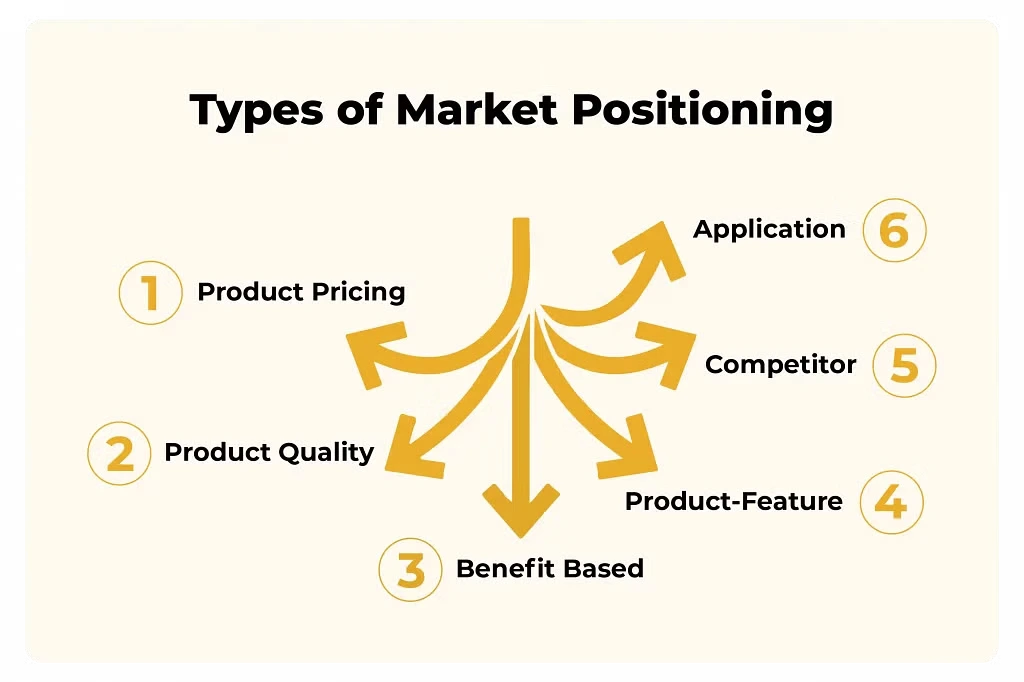Creating a successful brand relies not only on the quality of the product but also on how the audience receives it. However, that’s not all- there are a lot of factors at play when it comes to the success of the product including the target audience, the competitors in the market, and most importantly, product positioning.
What is Positioning in Marketing?

Positioning in marketing is the strategic placement of your product in the market in a way that it outperforms the competition while creating a unique identity among the target audience. By doing so, brands can significantly influence consumers’ buying decisions. In short, market positioning is a tactic that enables brands to differentiate with their competitors while making a strong impression on their target audience.
The main elements of market positioning include:
The product– Different brands offer different products. For instance, Starbucks is popular for its variety of coffees and other beverages, though it also has a range of other product offerings. So, what is their USP? The consumer can customize their beverage by choosing the type, the ingredients, and the quantity, making it convenient for them.
Every company has a different USP that buyers use to identify and relate with the brand. Having a development team or better yet, an expert eCommerce development agency can help you leverage the buyer’s interest and establish a unique brand identity.
The price– Pricing is another significant element that impacts product sales. Customers are often looking for high quality products at reasonable prices.Since your product may be sold across various platforms, price fluctuations are a given. It is best to set a price margin, so customers have a consistent range to work within.
The competition– Know your market. When a product is launched it is important to conduct a thorough analysis to decipher how the brand will perform against its competitors in the given market and what response can be expected from the target audience.
What are the Types of Market Positioning

There are various market positioning strategies that are used to emphasize on product features that influence customer perception and encourage purchases.
Different types of positioning strategies include:
1. Product Pricing
Creating an optimal price range is essential for market positioning. This strategy prioritizes the relation between pricing and quality while considering the consumers’ train of thought. Brands that offer good quality products at affordable prices are most preferred by consumers. High priced positioning is often associated with opulence and quality while a low priced positioning signifies affordability and value.
2. Product Quality Based Positioning
This strategy is used to emphasize the superior quality of the product. Sometimes, low prices don’t always mean quality. Brands that use this strategy usually highlight product craftsmanship, materials, performance, durability etc. Quality based positioning strategy is used by some of the biggest fashion brands, tech enterprises to luxury car brands, and more.
3. Benefit Based Positioning
Brands use this market positioning strategy to highlight the benefits their product offers including convenience, ease of use, performance, and even emotional benefits. Therefore, brands utilize this market positioning strategy to offer a solution to a problem or a requirement fulfilled better than their competitors, often tapping into the emotional and functional contributions of the product.
4. Product-Feature Based Positioning
We come across product-feature based market positioning when the brand wants to emphasize a particular attribute or innovation of their product that sets them apart. This works best when product differentiation is based on uniqueness in technology, design, or specific benefits that competitors may not offer. Take Dyson for instance, the brand emphasizes on advanced engineering such as cyclone vacuum technology and bladeless fans, etc.
5. Competitor-Based Positioning
This strategy is used in direct comparison with its competitors and is often bold. The primary focus is on how the product outperforms its competition or offers unique features, be it design, performance, or pricing. For instance, we have witnessed the feud between Apple and Samsung when new products are rolled out, this is a competitor based market positioning strategy.
6. Application-Based Positioning
This approach is used when the product is positioned based on how it addresses specific pain points or offers specific functionalities that are convenient and user-oriented. You can see brands use this market positioning when they focus on practical benefits, efficiency or application of their product. For example, Slack promotes itself as a tool for communication and collaboration in workplaces.
Different types of positioning strategies are combined to create a substantial market position, ensuring that the brand appeals to its target audience in different ways.
The Benefits of Positioning in Marketing

The key benefits of positioning in marketing include:
1. Competitive Advantage
With a market positioning strategy in place, brands can set themselves apart from their competitors. It allows you to clearly communicate how your product or service is unique or how it solves a problem better. This differentiation is crucial in crowded markets where many businesses offer similar products or services.
2. Targeted Marketing
With a well-defined position, brands can create and deliver marketing messages tailored to specific customer segments. With a seasoned Adobe commerce partner agency, you can have all your marketing requirements automated. This ensures that your promotional efforts reach the right audience, improving customer engagement and conversions.
3. Increased Brand Loyalty
Effective market positioning builds strong emotional connections with consumers. When customers connect with a brand, they are more likely to invest in it as it aligns with their requirements or values. This results in repeat purchases and brand loyalty.
4. Higher Perceived Value
Positioning your brand can influence how much your buyers are willing to pay for your product or service. A strong and well executed market position strategy can enhance perceived value and increase revenue.
5. Pricing Power
Brands that successfully position themselves in the market gain an advantage in pricing. Consumers are willing to pay a premium for products or services when they perceive added value, even if the price is slightly higher.
6. Increased Brand Awareness
By consistently communicating its unique position, a company can boost brand recognition, build a stronger and more relatable brand identity among its customer base.
7. Simplifies Decision Making For Customer
With a good market positioning strategy, brands can effectively propagate their values and how it fits the consumers needs. This eliminates confusion, making the purchasing process easier for your customers.
In conclusion, the importance of positioning in marketing cannot be overstated, especially for businesses aiming to stand out in a cut-throat environment. We have already established that a well defined market positioning strategy enables brands to differentiate themselves, resonate with their target audience and garner a loyal customer base. This can be more effectively achieved by working with an accomplished Magento partner agency who can provide tailored eCommerce solutions to empower your market positioning efforts.









